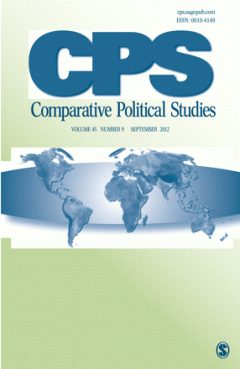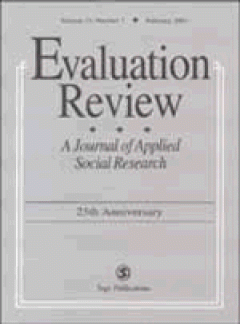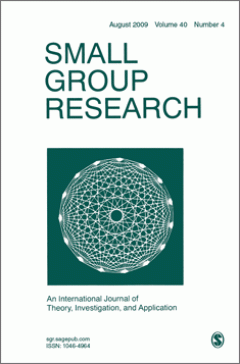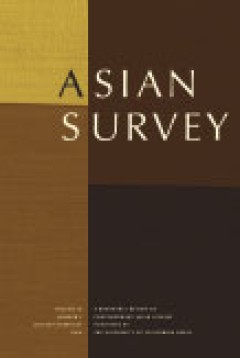Filter by

Anxious Publics : Worries About Crime and Immigration
In this article the authors investigate the relationship between concerns about crime and concerns about immigration. Panel survey data from Germany allow the authors to examine people’s views about immigration as they develop over time, showing that consternation about crime is a significant predictor of anxiety over immigration. Moreover, it has a greater substantive impact than other explana…
- Edition
- Vol. 45 no. 4, April 2012,pp. 477-506
- ISBN/ISSN
- 00104140
- Collation
- -
- Series Title
- Comparative Political Studies
- Call Number
- -

Use of Propensity Score Matching to Evaluate a National Smoking Cessation Med…
Sustained mass media campaigns have been recommended to stem the tobacco epidemic in the United States. Propensity score matching (PSM) was used to estimate the effect of awareness of a national smoking cessation media campaign (EX®) on quit attempts and cessation-related cognition. Participants were 4,067 smokers and recent quitters aged 18–49 in targeted U.S. media markets. Controlling for po…
- Edition
- Vol. 35 no. 6, December 2011,pp. 571-591
- ISBN/ISSN
- 0193841X
- Collation
- -
- Series Title
- Evaluation Review
- Call Number
- -

An Ex Post Facto Evaluation Framework for Place-Based Police Interventions
Background: A small but growing body of research evidence suggests that place-based police interventions generate significant crime control gains. While place-based policing strategies have been adopted by a majority of U.S. police departments, very few agencies make a priori commitments to rigorous evaluations. Objective: Recent methodological developments were applied to conduct a rigorous ex…
- Edition
- vol. 35 no. 6, December 2011,pp. 592-626
- ISBN/ISSN
- 0193841X
- Collation
- -
- Series Title
- Evaluation Review
- Call Number
- -

Covariate Imbalance and Precision in Measuring Treatment Effects
Covariate adjustment can increase the precision of estimates by removing unexplained variance from the error in randomized experiments, although chance covariate imbalance tends to counteract the improvement in precision. The author develops an easy measure to examine chance covariate imbalance in randomization by standardizing the average covariate difference between the treatment and control …
- Edition
- Vol. 35 no. 6, December 2011,pp. 627-641
- ISBN/ISSN
- 0193841X
- Collation
- -
- Series Title
- Evaluation Review
- Call Number
- -

Reconciling the Multiple Objectives of Prison Diversion Programs for Drug Off…
Background: In recent years, several states have created mandatory prison-diversion programs for felony drug possessors. These programs have both individual-level goals of reducing recidivism rates and system-level goals of reducing prison populations. Objective: This study examines the individual level and system level impact of Kansas’ Senate Bill 123 (SB 123), which created mandatory probati…
- Edition
- Vol. 35 no. 6, December 2011,pp. 642-672
- ISBN/ISSN
- 0193841X
- Collation
- -
- Series Title
- Evaluation Review
- Call Number
- -

Evaluating Free-Choice Climate Education Interventions Applying Propensity Sc…
Background and objectives. The majority of environmental education takes place in informal settings, of which so-called free-choice learning is typical. What is understood by this is a kind of learning which is self-determined and driven by the needs and interests of the learner. The voluntariness of participation in interventions and the fact that they take place in turbulent action settings l…
- Edition
- Vol. 35 no. 6, December 2011,pp. 673-722
- ISBN/ISSN
- 0193841X
- Collation
- -
- Series Title
- Evaluation Review
- Call Number
- -

Meetings at Work : Advancing the Theory and Practice of Meetings
Although advances in communication technology were once expected to diminish the need for synchronous work meetings, meeting activity in organizations continues to rise. Regrettably, the time and energy employees spend in work meetings is not matched by the amount of direct attention group and organizational scholars have paid to meeting phenomena. This special issue of Small Group Research hel…
- Edition
- Vol. 43 no. 2, April 2012,pp. 127-129
- ISBN/ISSN
- 10464964
- Collation
- -
- Series Title
- Small Group Research
- Call Number
- -

Meetings Matter : Effects of Team Meetings on Team and Organizational Success
This study follows the idea that the key to understanding team meeting effectiveness lies in uncovering the microlevel interaction processes throughout the meeting. Ninety-two regular team meetings were videotaped. Interaction data were coded and evaluated with the act4teams coding scheme and INTERACT software. Team and organizational success variables were gathered via questionnaires and telep…
- Edition
- Vol. 43 no. 2, April 2012,pp. 130-158
- ISBN/ISSN
- 10464964
- Collation
- -
- Series Title
- Small Group Research
- Call Number
- -

The Meeting Genre Across Cultures : Insights From Three German–American Col…
The current study examines cross-cultural differences in norms for meetings. Following Eisenhardt, we used a broad set of conceptual dimensions for analyzing meetings as a genre of organizational communication (Yates & Orlikowski) to guide a within- and cross-case analysis of meetings in two cultures. Our goal was to discover the possible existence of patterns and interpretations within culture…
- Edition
- Vol. 43 no. 2, April 2012,pp. 159-185
- ISBN/ISSN
- 10464964
- Collation
- -
- Series Title
- Small Group Research
- Call Number
- -

Team Meeting Attitudes : Conceptualization and Investigation of a New Construct
Although most work teams use meetings as a tool for accomplishing their objectives, there is little research examining meeting-related variables in teams. In this article, we propose a new construct, team meeting attitudes (TMA), that involves individuals’ thoughts, feelings, and evaluations of team meetings. We constructed a scale that measures individuals’ TMA, and we report on the scale’s ps…
- Edition
- Vol. 43 no. 2, April 2012,pp. 186-210
- ISBN/ISSN
- 10464964
- Collation
- -
- Series Title
- Small Group Research
- Call Number
- -

Public Meeting Facilitation : A Naïve Theory Analysis of Crisis Meeting Inte…
During the record 2009 flood, the city of Fargo, North Dakota, United States held daily televised public meetings. Unknown to many citizens, the city also held private premeetings to prepare for the public meetings. The present study examined city leaders’ naďve theories of meeting facilitation in light of a minimalist view of public meetings (McComas, 2001). Interviews of city leaders during a…
- Edition
- Vol. 43 no. 2, April 2012,pp. 211-235
- ISBN/ISSN
- 10464964
- Collation
- -
- Series Title
- Small Group Research
- Call Number
- -

Wasted Time and Money in Meetings : Increasing Return on Investment
Meetings are a significant investment for organizations and the groups that comprise them, but the small group literature has often neglected the direct study of meetings. This article closes the special issue on work meetings by exploring the costs associated with unnecessary or poorly facilitated meetings and proposes a three-stage model that groups and organizations may use to assure that th…
- Edition
- Vol. 43 no. 2, April 2012,pp. 236-245
- ISBN/ISSN
- 10464964
- Collation
- -
- Series Title
- Small Group Research
- Call Number
- -

Has the British Public Depolarized Along With Political Elites? An American P…
In contrast to the growing elite policy polarization in the United States, the British Labour and Conservative Parties have converged dramatically on economic and social welfare policy over the past two decades. The authors ask the following question: Has there been a parallel depolarization in the British mass public’s policy attitudes and partisan loyalties, pointing to a general mechanism th…
- Edition
- Vol. 45 no. 4, April 2012, pp. 507-530
- ISBN/ISSN
- 00104140
- Collation
- -
- Series Title
- Comparative Political Studies
- Call Number
- -

The United States and Asia in 2011 : Obama Determined to Bring America “Bac…
The Obama administration moved to stabilize 2010's deteriorating relations with China and exploit the opportunity to deepen ties with China's nervous neighbors. Diplomatic, economic, and security initiatives were melded to “rebalance” American resources and attention to Asia in the 21st century. Early 2011 euphoria about China's rise and gloom about America's decline began to reverse themselves…
- Edition
- Vol. 52, No. 1, Januari/February 2012, pp. 6-14
- ISBN/ISSN
- 00044687
- Collation
- -
- Series Title
- Asian Survey
- Call Number
- -

China in 2011 : Anger, Political Consciousness, Anxiety, and Uncertainty
This paper identifies major trends in China in 2011 and analyzes their implications. The past year has witnessed a continuous rise of anger among social groups, as demonstrated in various forms of social protests. Chinese intellectuals are becoming increasingly politically conscious and calling for political reform. However, the leadership is trapped in the politics of power succession; uncerta…
- Edition
- Vol. 52, No. 1, January/February 2012, pp. 28-41
- ISBN/ISSN
- 00044687
- Collation
- -
- Series Title
- Asian Survey
- Call Number
- -

Japan in 2011 : Cataclysmic Crisis and Chronic Deflation
Japan's government under the Democratic Party of Japan has limped along for another year, hampered by a divided legislature and an aging population reluctant to pay for the pensions and services it requires. The natural disasters of March 2011 were a tragic sideshow to the deep political problems that continue to plague Japan.
- Edition
- Vol. 52, No. 1, January/February 2012, pp. 15-27
- ISBN/ISSN
- 00044687
- Collation
- -
- Series Title
- Asian Survey
- Call Number
- -

Russia and the CIS in 2011 : Uncertain Economic Recovery
During 2011, Russia made progress in recovering from the global financial crisis and moved toward further political centralization. Moscow also continued to prepare for an uncertain new world by pursuing pragmatic relations with Western and non-Western powers and by seeking to increase its influence among the states of the Commonwealth of Independent States.1
- Edition
- Vol. 52, No. 1, January/February 2012, pp. 42-51
- ISBN/ISSN
- 00044687
- Collation
- -
- Series Title
- Asian Survey
- Call Number
- -

Women producers and the benefits of collective forms of enterprise
This article summarises the findings of an action research project examining the experience of women producers in various collective enterprises, all linked to the Fair Trade movement, in seven countries in Asia, Africa, and Latin America. What are the benefits of collective enterprise for women producers? The study found that participating in collective forms of enterprise and linking to Fair …
- Edition
- Volume 20, Issue 1, March 2012, pp. 13-32
- ISBN/ISSN
- 13552074
- Collation
- -
- Series Title
- Gender & Development
- Call Number
- -

Shampoo, saris and SIM cards : seeking entrepreneurial futures at the bottom …
In recent years bottom-of-the-pyramid (BoP) models have emerged as a popular strategy for offering poor women the opportunity to earn an income by distributing goods and services door-to-door. In this article, we explore one recent example of BoP entrepreneurship: the CARE Bangladesh Rural Sales Program (RSP). The RSP is a partnership between CARE and several multinational and domestic companie…
- Edition
- Volume 20, Issue 1, March 2012, pages 33-47
- ISBN/ISSN
- 13552074
- Collation
- -
- Series Title
- Gender & Development
- Call Number
- -

Workers' rights and corporate accountability – the move towards practical, …
Women workers across Asia and throughout the world continue to face long hours, low wages and discrimination when they try to organise into unions within garment and footwear factories. Millions of young women are making products for companies Nike and Adidas. Over the past decade, under considerable public pressure, these companies have developed standards on workers conditions for their suppl…
- Edition
- Volume 20, Issue 1, March 2012, pages 49-65
- ISBN/ISSN
- 13552074
- Collation
- -
- Series Title
- Gender & Development
- Call Number
- -
 Computer Science, Information & General Works
Computer Science, Information & General Works  Philosophy & Psychology
Philosophy & Psychology  Religion
Religion  Social Sciences
Social Sciences  Language
Language  Pure Science
Pure Science  Applied Sciences
Applied Sciences  Art & Recreation
Art & Recreation  Literature
Literature  History & Geography
History & Geography